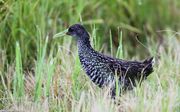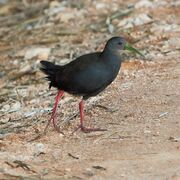Biology:Pardirallus
| Pardirallus | |
|---|---|
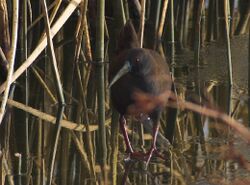
| |
| Plumbeous rail (Pardirallus sanguinolentus) | |
| Scientific classification | |
| Domain: | Eukaryota |
| Kingdom: | Animalia |
| Phylum: | Chordata |
| Class: | Aves |
| Order: | Gruiformes |
| Family: | Rallidae |
| Genus: | Pardirallus Bonaparte, 1856 |
| Type species | |
| Rallus variegatus[1] Gmelin, 1789
| |
| Species | |
|
P. maculatus | |
Pardirallus is a genus of bird in the family Rallidae. It contains three species native to marshland areas of Southern, Central America and the Caribbean, although fossil evidence indicates they once ranged north to what is now Idaho.[2] They are 25–38 cm long and have a long greenish bill and reddish legs. The spotted rail is blackish-brown with white markings while the other two are brown above and dark grey below.[2]
The genus Pardirallus was erected by the French naturalist Charles Lucien Bonaparte in 1856 with the spotted rail (Pardirallus maculatus) as the type species.[3][4] The generic name combines the Ancient Greek pardos meaning "leopard" with the genus Rallus.[5]
Species
The genus contains three species :[6]
| Common name | Scientific name and subspecies | Range | Size and ecology | IUCN status and estimated population |
|---|---|---|---|---|
| Spotted rail | Pardirallus maculatus (Boddaert, 1783) Two subspecies
|
Argentina, Belize, Bolivia, Brazil, Cayman Islands, Chile, Colombia, Costa Rica, Cuba, the Dominican Republic, Ecuador, El Salvador, French Guiana, Guyana, Jamaica, Mexico, Panama, Paraguay, Peru, Suriname, Trinidad and Tobago, Uruguay, Venezuela, and possibly Honduras.
|
Size: Habitat: Diet: |
LC
|
| Blackish rail | Pardirallus nigricans (Swainson, 1838) Two subspecies
|
north-eastern Brazil south to south-east Brazil and west to northern Argentina and eastern Paraguay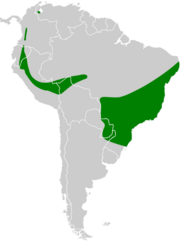
|
Size: Habitat: Diet: |
LC
|
| Plumbeous rail | Pardirallus sanguinolentus (Loddiges, 1832) Six subspecies
|
Argentina, Bolivia, Brazil, Chile, Ecuador, Paraguay, Peru and Uruguay, and is a vagrant to the Falkland Islands.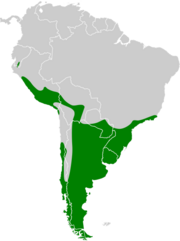
|
Size: Habitat: Diet: |
LC
|
A fossil species, Pardirallus lacustris, is known from the Late Pliocene of the Hagerman Fossil Beds of Idaho. It was formerly assigned to the genus Porzana upon its description in 1958 by Pierce Brodkorb and later to the genus Rallus in 1968 by Alan Feduccia, but an analysis by Storrs L. Olson in 1977 transferred it to Pardirallus.[7]
References
- ↑ "Rallidae". The Trust for Avian Systematics. https://www.aviansystematics.org/4th-edition-checklist?viewfamilies=42.
- ↑ 2.0 2.1 Taylor, Barry & Ber van Perlo (1998). Rails: A Guide to the Rails, Crakes, Gallinules and Coots of the World. Sussex: Pica Press.
- ↑ Bonaparte, Charles Lucien (1856). "Excusion dans les divers Musées d'Allemagne, de Hollande et de Belgique (suite)" (in French). Comptes Rendus Hebdomadaires des Séances de l'Académie des Sciences 43: 593–601 [599]. https://biodiversitylibrary.org/page/1211135.
- ↑ Peters, James Lee, ed (1934). Check-list of Birds of the World. 2. Cambridge, Massachusetts: Harvard University Press. p. 169. https://biodiversitylibrary.org/page/14482982.
- ↑ Jobling, James A. (2010). The Helm Dictionary of Scientific Bird Names. London: Christopher Helm. p. 292. ISBN 978-1-4081-2501-4. https://archive.org/details/Helm_Dictionary_of_Scientific_Bird_Names_by_James_A._Jobling.
- ↑ Gill, Frank; Donsker, David, eds (2019). "Flufftails, finfoots, rails, trumpeters, cranes, limpkin". World Bird List Version 9.2. International Ornithologists' Union. https://www.worldbirdnames.org/bow/flufftails/. Retrieved 18 July 2019.
- ↑ Olson, Storrs L. (1977). "A synopsis of the fossil Rallidae". Rails of the World: A Monograph of the Family Rallidae. Boston, MA, USA: David R. Godine. pp. 339–373. http://repository.si.edu/xmlui/handle/10088/12826.
External links
Wikidata ☰ Q2603364 entry
 |
